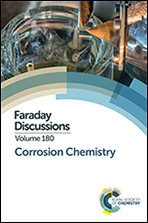Atmospheric pitting corrosion of 304L stainless steel: the role of highly concentrated chloride solutions
Abstract
The morphology of atmospheric pitting corrosion in 304L stainless steel plate was analysed using MgCl2 droplets in relation to changes in relative humidity (RH) and chloride deposition density (CDD). It was found that highly reproducible morphologies occur that are distinct at different RH. Pitting at higher concentrations, i.e. lower RH, resulted in satellite pits forming around the perimeter of wide shallow dish regions. At higher RH, these satellite pits did not form and instead spiral attack into the shallow region was observed. Increasing CDD at saturation resulted in a very broad-mouthed pitting attack within the shallow dish region. Large data sets were used to find trends in pit size and morphology in what is essentially a heterogeneous alloy. Electrochemical experiments on 304 stainless steel wires in highly saturated solutions showed that the passive current density increased significantly above 3 M MgCl2 and the breakdown pitting potential dropped as the concentration increased. It is proposed that the shallow dish regions grow via enhanced dissolution of the passive film, whereas satellite pits and a spiral attack take place with active dissolution of bare metal surfaces.
- This article is part of the themed collection: Corrosion Chemistry

 Please wait while we load your content...
Please wait while we load your content...